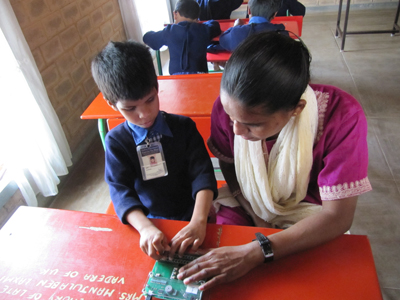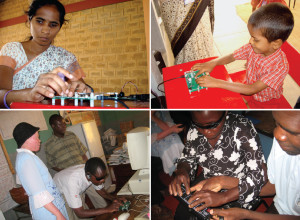Carnegie Mellon Students Invent New Way to Teach Braille

Computer science students at Carnegie Mellon University in Pittsburgh, Pennsylvania, have designed an innovative device to teach Braille to blind students without using Braille Paper or a slate and stylus. The Braille Tutor for blind children, which was developed as part of the CMU TechBridgeWorld program, has already been used to teach Braille to impoverished blind children in India, Tanzania, and Zambia.
According to Dr. Bernardine Dias of the CMU computer sciences department, the Braille Tutor project began to take form in 2006. Dr. Dias and her project team first realized that the little black box had potential after successfully using the device to teach Braille to students at Mathru, a school for the blind in Bangalore, India. Even children who lacked the ability to conceptualize Braille could learn with the assistance of the Braille Tutor.
According to Ermin Teeves, project manager of TechBridgeWorld, CMU’s computerized Braille Tutor eliminates the cost of Braille paper and the frustration of embossing raised dots with a slate and stylus. Students have even developed a model that requires only a set of speakers to listen to the audio cues and instructions that help students learn the alphabet in Braille.
 Dr. Dias founded TechBridgeWorld to provide an avenue for Carnegie Mellon computer science students to create simple technology with the goal of assisting impoverished communities throughout the world. The Braille Tutor was one of the first projects to emerge from the TechBridgeWorld program. Although the project was initiated by CMU graduate students more than a decade ago, a series of ambitious students and computer science staff have kept development alive.
Dr. Dias founded TechBridgeWorld to provide an avenue for Carnegie Mellon computer science students to create simple technology with the goal of assisting impoverished communities throughout the world. The Braille Tutor was one of the first projects to emerge from the TechBridgeWorld program. Although the project was initiated by CMU graduate students more than a decade ago, a series of ambitious students and computer science staff have kept development alive.
TechBridgeWorld plans to continue development of the device. The students are already working on a version that can be connected to a Smartphone. Newer versions of the Braille Tutor eliminate the need for an external computer and allow students to use a stylus, consult an audio tutor, or both. Dr. Dias and the project team hope to strengthen their partnership with schools for the blind in impoverished areas of the world.
